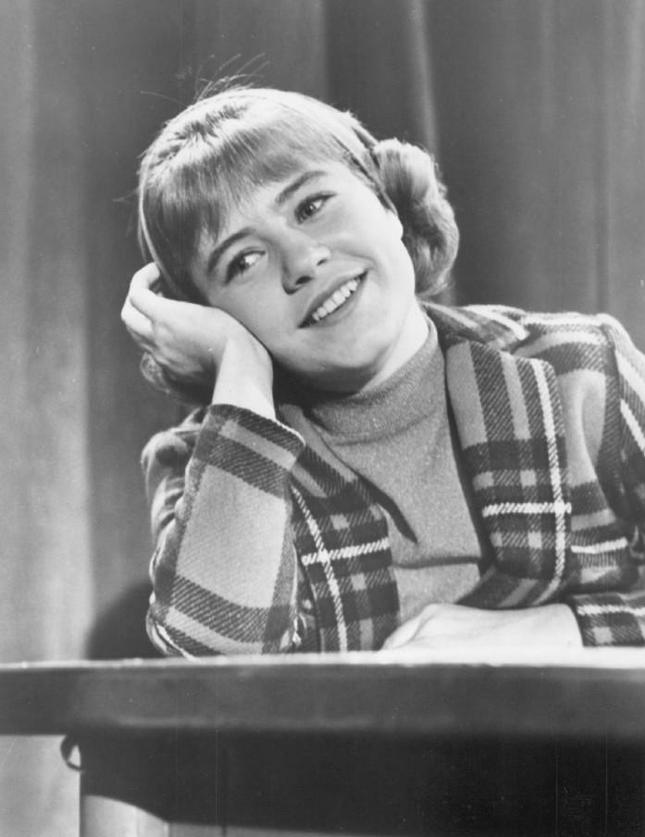Patty Duke: Nothing Typical
By • April 18, 2016 0 913

If you look at the many pictures of the Oscar-winning actress Patty Duke, who died at the age of 69 this week, you’ll see two or three things that take her out of the classic Hollywood milieu of female stars.
First of all, there was nothing typical about Duke’s rise to prominence at a very early age, or even about her struggles thereafter, both of which she wrote about cleanly and honestly in her autobiography “Call Me Anna” in 1987. She was by any measure abused and/or abandoned by her parents, and by her agents who changed her name and robbed her of much of earnings. She also suffered from bipolarism, a clinical condition which she fought all of her life.
The record of her life photographically isn’t so much a collection of snapshots, or celebrity paparazzi records, or glamour stills that mark the resume and files of most female actresses. It’s a progression — of her profession, but also of her life. She started out in commercials and soaps on television, but then snagged a remarkable stage role on Broadway, opposite Anne Bancroft, playing the child Helen Keller in William Gibson’s “The Miracle Worker,” a play which ran for almost two years.
That success was repeated in the black-and-white film version directed by Arthur Penn. Her performance won Duke an Academy Award for best supporting actress, with Bancroft winning the Best Actress Award. At 16, Duke was the youngest actress to ever win an Oscar at the time. (Tatum O’Neal, who had a far different sort of career path, would later win the Oscar for “Paper Moon” at the age of ten, acting with her father Ryan.)
When she received her award, from George Chakiris of “West Side Story,” Duke looked every bit the little teenaged lady in a grown-up gown, with tears flowing, clutching the Oscar. She simply said, “Thank you,” beating O’Neal (who said “I just want to thank my director, Peter Bogdanovich, and my father”) for brevity.
This was followed by a different sort of stardom in the TV sitcom “The Patty Duke Show,” in which she played identical twin cousins — one a classical music lover and little adult, the other a rock-and-roller — from 1963 through 1966. The show, which still has its followers and people who can sing the entire theme song, was one of those wholesome and somewhat silly antidotes to the different sort of youth culture that was raging outside the television tube in the 1960s.
Duke followed that with an over-the-top but effective appearance in “Valley of the Dolls,” in which she played a pill-popping, boozing vaudeville star on the way down.
Turned out there was quite a connection to both efforts in terms of Duke’s personal life. That ability to play two radically different personalities in the sitcom was a reflection of her real-life bipolar issues, which in turn played out in often out-of-control behavior during several marriages.
She returned to television often, including playing the Anne Bancroft role in a TV movie of “The Miracle Worker” and a number of highly praised roles in what might be called social-problem television movies. All along, she grew professionally, playing whistle-blowers, mothers, professionals and abused spouses with a kind of dignity and crisp intelligence that did not scream “Hollywood star.”
If you watched her then, you saw somebody different: the talent that was on such grand display in “The Miracle Worker” and, in lesser ways, in “The Patty Duke Show” remained, but with the addition of a kind of maturity.
That’s what you notice about the photographs of her, too. She looked different every time out, although it’s fair to say the inner talent shined through. The progression — with all the personal troubles, the four marriages, the addictions, the medical and mental issues — was nonetheless apparent. She wasn’t vying for awards, stardom, an extension of youth, none of the things that make maturity such a difficult thing for Hollywood stars. In all those television movies, her name remained the same, but her persona fleshed out into someone authentic — a rare thing in Hollywood, where everything is after all make-believe, a suspension of all belief.
In those films, she aged, just like everyone else. And her work matured, to a kind of plainspoken articulation of the dramatic situation in which she was involved. Personally, too, there was a maturation, a surmounting of chaos. And once she started talking about her bipolar disorder, she found a cause, too, as a mental health advocate, founding a mental health foundation that bears her name.
She married her fourth husband, drill sergeant Michael Pearce, in 1986. They were still husband and wife at the time of her death at the age of 69.
In the pictures, Duke gradually, sometimes painfully, always with interest, became something you rarely see among the stars:
A grown-up at the center of a life fully lived.

